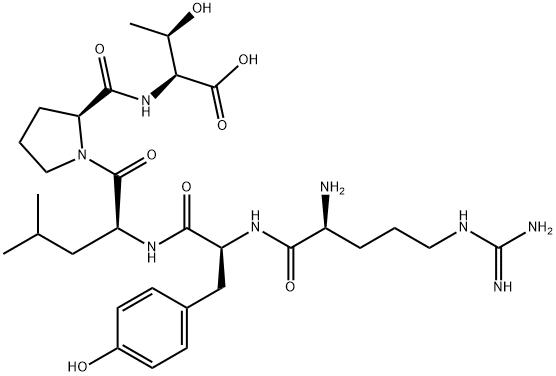57966-42-4
 57966-42-4 結(jié)構(gòu)式
57966-42-4 結(jié)構(gòu)式
基本信息
2-[[1-[2-[[2-[[2-AMINO-5-(DIAMINOMETHYLIDENEAMINO)PENTANOYL]AMINO]-3-(4-HYDROXYPHENYL)PROPANOYL]AMINO]-4-METHYLPENTANOYL]PYRROLIDINE-2-CARBONYL]AMINO]-3-HYDROXYBUTANOIC ACID
L-Arg-L-Tyr-L-Leu-L-Pro-L-Thr-OH
L-Threonine, L-arginyl-L-tyrosyl-L-leucyl-L-prolyl-
2-[[1-[2-[[2-[[2-amino-5-(diaminomethylideneamino)pentanoyl]amino]-3-(4-hydroxyphenyl)propanoyl]amino]-4-methylpentanoyl]pyrrolidine-2-carbonyl]amino]-3-hydroxybutanoicacid
物理化學性質(zhì)
常見問題列表
Proctolin can increase the frequency of action potentials, increase the amplitude of muscle contraction, and initiate activity in quiescent systems. In the arthropods, Proctolin acts as a neuromodulator and possibly as a neurohormone. It does not appear to function as a conventional neurotransmitter. Proctolin is a pentapeptide with the mature peptide of RYLPT, and it is the first insect neuropeptide to be sequenced and chemically characterized. The first identification of a Proctolin precursor gene is CG7105 in D. melanogaster . Although a previous study showed that Proctolin is absent in B. mori , this pentapeptide is recently identified in a proteomic analysis of B. mori wings. However, the Bombyx Proctolin gene does not produce a mature peptide because cleavage sites are not present at the N-terminal and C-terminal of the RYLPT sequence, and a similar gene is observed in C. suppressalis . Therefore, a true Proctolin has been considered to be not observed in B. mori and C. suppressalis .